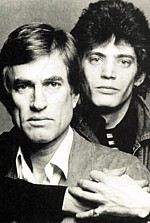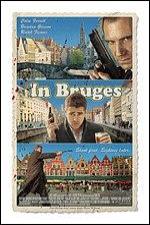
Knight at the Movies Archives
Brendan Gleeson and Colin Farrell make a dynamic acting duo, Sam Wagstaff and Robert Mapplethorpe set the art world on its ear
Lake Placid is a not very good B picture about a giant crocodile that lives in the title body of water and feasts on the local residents.
The movie is wildly uneven in tone but is sustained by some very good performances from an odd assemblage of talent – Bridget
Fonda, Bill Pullman, Oliver Platt, Betty White (yes, Betty White), and the Irish actor Brendan Gleeson as the small town sheriff. Of all
the performances it was Gleeson’s that resonated when I saw the movie in 1999. I’d seen Gleeson in several small parts before but
this performance, small though it was, finally sent me in search of some background information on this enormously talented
performer.
Like George Sanders and Thelma Ritter before him, Gleeson, (perhaps best known to movies audiences portraying ‘Mad Eye’ Moony
in the Harry Potter series) is one of those character actors that can save a bad movie and make a good one great. He’s so good
(he's like an Irish Spencer Tracy), conveys so much and so naturally his great skill almost goes unnoticed. When he is given a
starring role as in the new black comedy In Bruges the effect of his work is deeply satisfying. Matched up with co-star (and
marquee draw) Colin Farrell who is also gifted (but in a more showy way), the duo enact a new variation on the buddy picture – one
with a soul.
Gleeson and Farrell, respectively, play Ken and Ray, two hitmen who have been ordered by their boss Harry (Ralph Fiennes) to lay
low in Bruges, Belgium after a gruesome hit has gone off the rails in the tiny Flemish village until he phones up with orders for their
next target. It’s just before Christmas and Ken, a quiet, cultured man, is immediately in his glory, taking in the picture postcard
town with its cobbled streets, medieval buildings, gently flowing canals, and tower with its dazzling view of the area. But Ray, his
much younger counterpoint, who is new to the job (and jittery after it hasn’t gone as planned) is bored stiff. Until he spots a dwarf
named Jimmy (Jordan Prentice) making a movie and one of the townspeople, Chloë (Clémence Poésy) watching the filming. The
two pursue their separate agendas until the call from the dreaded Harry comes at last.
For Harry (whose every other word is “fuck”) is as frightening and monstrous a figure as Don Logan, the lethal killer played by Ben
Kingsley in Sexy Beast and Fiennes brings the same insane intensity to Harry that Kingsley brought to Don Logan (the two could be
brothers). He has the same barely contained, purposeful stride – like a walking shark – so dangerous that others instinctively know
to get out of his way.
When Harry shows up the picture shifts into high gear and changes from black comedy into a treatise on honor and redemption
accompanied by several violent set pieces. Until then, In Bruges is a very quiet film (apt given the reflective nature of the two
leading characters) and the piano based music score by Carter Burwell helps sustain the mood. It’s no surprise to find, given the
movie’s seesawing between poetic despair and the fidgets, measured quiet and brutal in your face violence that it’s been written and
directed by Martin McDonagh, who has been dubbed the “Irish Tarantino.” McDonagh won international acclaim for his plays “The
Beauty Queen of Leenane,” “The Pillowman,” and others and he won an Oscar for his first film, a short titled Six Shooter (which also
starred Gleeson). In Bruges is his feature debut. It’s another one of those improbable but deftly entertaining hit men pictures. Like
The Matador, Grosse Point Blank and many others in the genre the character of the assassin(s), so hard to comprehend even in our
narcissistic, mean spirited culture, is examined, sometimes explained and once in a while redeemed.
Like the best of McDonagh’s work In Bruges has unforgettable moments of depth, lots of pitch black humor, outrageous,
unbelievable twists that are nevertheless quite entertaining and the teaming of Gleeson and Farrell (the relationship is more father-
son than buddy buddy to be honest) who jointly deliver an acting knock out.
+++++++++++++++++++++++++++++++++++++++++++++++++++++++++++++++++++++++++++++++++++++++++++++
Black White + Gray: A Portrait of Sam Wagstaff and Robert Mapplethorpe is a documentary look at Wagstaff, the rich
art collector and Mapplethorpe, the beautiful young photographer, his lover whom he also helped elevate to international status as
an artist. The film, beautifully shot, plays its Chicago premiere February 8-14 at the Gene Siskel Film Center.
James Crump’s film is greatly aided by the in-depth observations of the one person who seemed to connect with both –
musician/poet Patti Smith. Smith and Mapplethorpe were roommates (she was perhaps his greatest photographic subject) and she
followed the relationship of Mapplethorpe with the wealthy Wagstaff throughout its trajectory. Though Mapplethorpe, with his still
controversial images of gay S&M practices, is the film’s drawing card, it’s really more a portrait of Wagstaff. But that’s to the good as
the elusive, rich Wagstaff with his unerring artistic eye, who turned his back on his family’s WASP expectations is in many ways a
much more interesting subject than the career driven Mapplethorpe (even Smith honestly observes that Mapplethorpe’s interests
were mostly self-motivated).
The film, which is compellingly narrated by Joan Juliet Buck is packed with vintage clips, dazzling photographs from Wagstaff’s
collection (including plenty of Mapplethorpe’s), and the reminiscences of others privy to the relationship of the two men (which comes
across as both mentor/student and user/used in the retelling). Even more fascinating than the oft told story of Wagstaff using his
influence and money to make Mapplethorpe a star in the art world is the tantalizing idea of the couple purposely enacting a punk
era, gay version of the Stieglitz-O’Keeffe relationship. The film tries hard to diffuse this kind of mythmaking but it stubbornly hovers
over the movie anyway and one suspects that these two brilliant manipulators wouldn’t have it any other way. Let’s hope this is the
springboard for a biopic on the art world’s dynamic gay duo – maybe by the time it gets made we’ll even have some openly gay
actors to play the parts.
The movie is wildly uneven in tone but is sustained by some very good performances from an odd assemblage of talent – Bridget
Fonda, Bill Pullman, Oliver Platt, Betty White (yes, Betty White), and the Irish actor Brendan Gleeson as the small town sheriff. Of all
the performances it was Gleeson’s that resonated when I saw the movie in 1999. I’d seen Gleeson in several small parts before but
this performance, small though it was, finally sent me in search of some background information on this enormously talented
performer.
Like George Sanders and Thelma Ritter before him, Gleeson, (perhaps best known to movies audiences portraying ‘Mad Eye’ Moony
in the Harry Potter series) is one of those character actors that can save a bad movie and make a good one great. He’s so good
(he's like an Irish Spencer Tracy), conveys so much and so naturally his great skill almost goes unnoticed. When he is given a
starring role as in the new black comedy In Bruges the effect of his work is deeply satisfying. Matched up with co-star (and
marquee draw) Colin Farrell who is also gifted (but in a more showy way), the duo enact a new variation on the buddy picture – one
with a soul.
Gleeson and Farrell, respectively, play Ken and Ray, two hitmen who have been ordered by their boss Harry (Ralph Fiennes) to lay
low in Bruges, Belgium after a gruesome hit has gone off the rails in the tiny Flemish village until he phones up with orders for their
next target. It’s just before Christmas and Ken, a quiet, cultured man, is immediately in his glory, taking in the picture postcard
town with its cobbled streets, medieval buildings, gently flowing canals, and tower with its dazzling view of the area. But Ray, his
much younger counterpoint, who is new to the job (and jittery after it hasn’t gone as planned) is bored stiff. Until he spots a dwarf
named Jimmy (Jordan Prentice) making a movie and one of the townspeople, Chloë (Clémence Poésy) watching the filming. The
two pursue their separate agendas until the call from the dreaded Harry comes at last.
For Harry (whose every other word is “fuck”) is as frightening and monstrous a figure as Don Logan, the lethal killer played by Ben
Kingsley in Sexy Beast and Fiennes brings the same insane intensity to Harry that Kingsley brought to Don Logan (the two could be
brothers). He has the same barely contained, purposeful stride – like a walking shark – so dangerous that others instinctively know
to get out of his way.
When Harry shows up the picture shifts into high gear and changes from black comedy into a treatise on honor and redemption
accompanied by several violent set pieces. Until then, In Bruges is a very quiet film (apt given the reflective nature of the two
leading characters) and the piano based music score by Carter Burwell helps sustain the mood. It’s no surprise to find, given the
movie’s seesawing between poetic despair and the fidgets, measured quiet and brutal in your face violence that it’s been written and
directed by Martin McDonagh, who has been dubbed the “Irish Tarantino.” McDonagh won international acclaim for his plays “The
Beauty Queen of Leenane,” “The Pillowman,” and others and he won an Oscar for his first film, a short titled Six Shooter (which also
starred Gleeson). In Bruges is his feature debut. It’s another one of those improbable but deftly entertaining hit men pictures. Like
The Matador, Grosse Point Blank and many others in the genre the character of the assassin(s), so hard to comprehend even in our
narcissistic, mean spirited culture, is examined, sometimes explained and once in a while redeemed.
Like the best of McDonagh’s work In Bruges has unforgettable moments of depth, lots of pitch black humor, outrageous,
unbelievable twists that are nevertheless quite entertaining and the teaming of Gleeson and Farrell (the relationship is more father-
son than buddy buddy to be honest) who jointly deliver an acting knock out.
+++++++++++++++++++++++++++++++++++++++++++++++++++++++++++++++++++++++++++++++++++++++++++++
Black White + Gray: A Portrait of Sam Wagstaff and Robert Mapplethorpe is a documentary look at Wagstaff, the rich
art collector and Mapplethorpe, the beautiful young photographer, his lover whom he also helped elevate to international status as
an artist. The film, beautifully shot, plays its Chicago premiere February 8-14 at the Gene Siskel Film Center.
James Crump’s film is greatly aided by the in-depth observations of the one person who seemed to connect with both –
musician/poet Patti Smith. Smith and Mapplethorpe were roommates (she was perhaps his greatest photographic subject) and she
followed the relationship of Mapplethorpe with the wealthy Wagstaff throughout its trajectory. Though Mapplethorpe, with his still
controversial images of gay S&M practices, is the film’s drawing card, it’s really more a portrait of Wagstaff. But that’s to the good as
the elusive, rich Wagstaff with his unerring artistic eye, who turned his back on his family’s WASP expectations is in many ways a
much more interesting subject than the career driven Mapplethorpe (even Smith honestly observes that Mapplethorpe’s interests
were mostly self-motivated).
The film, which is compellingly narrated by Joan Juliet Buck is packed with vintage clips, dazzling photographs from Wagstaff’s
collection (including plenty of Mapplethorpe’s), and the reminiscences of others privy to the relationship of the two men (which comes
across as both mentor/student and user/used in the retelling). Even more fascinating than the oft told story of Wagstaff using his
influence and money to make Mapplethorpe a star in the art world is the tantalizing idea of the couple purposely enacting a punk
era, gay version of the Stieglitz-O’Keeffe relationship. The film tries hard to diffuse this kind of mythmaking but it stubbornly hovers
over the movie anyway and one suspects that these two brilliant manipulators wouldn’t have it any other way. Let’s hope this is the
springboard for a biopic on the art world’s dynamic gay duo – maybe by the time it gets made we’ll even have some openly gay
actors to play the parts.
Male Mentors:
In Bruges-Black White + Gray: A Portrait of Sam Wagstaff and Robert Mapplethorpe
Expanded Edition of 2-6-08 Windy City Times Knight at the Movies Column
By Richard Knight, Jr.
In Bruges-Black White + Gray: A Portrait of Sam Wagstaff and Robert Mapplethorpe
Expanded Edition of 2-6-08 Windy City Times Knight at the Movies Column
By Richard Knight, Jr.


